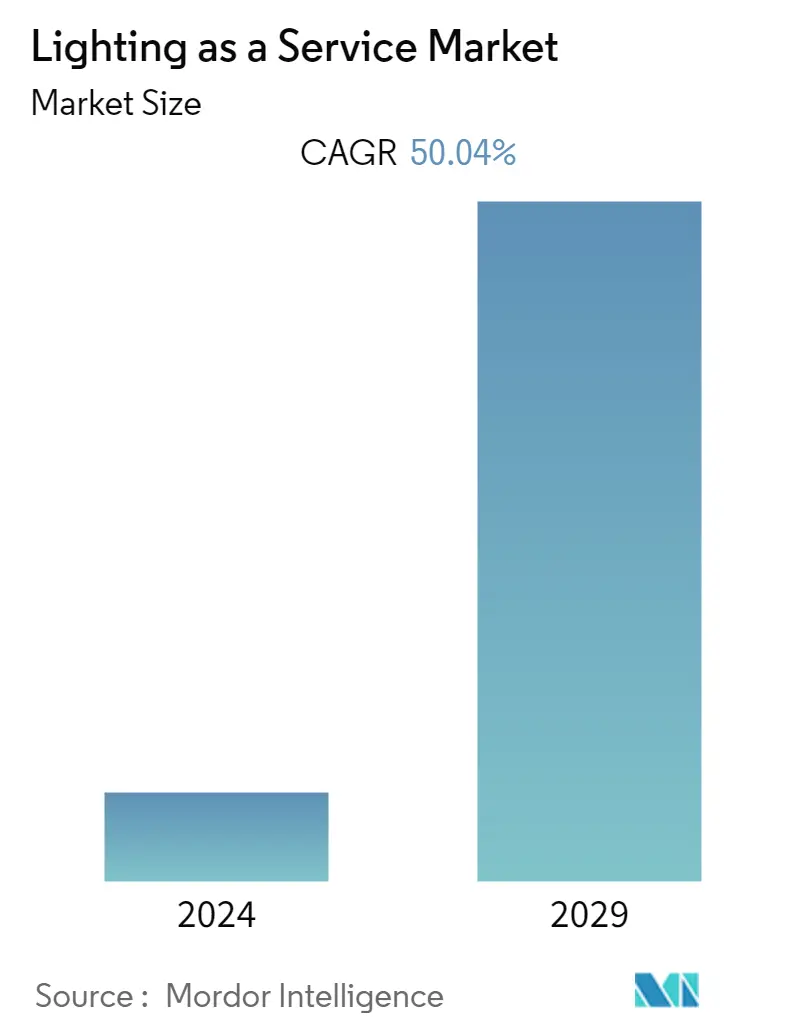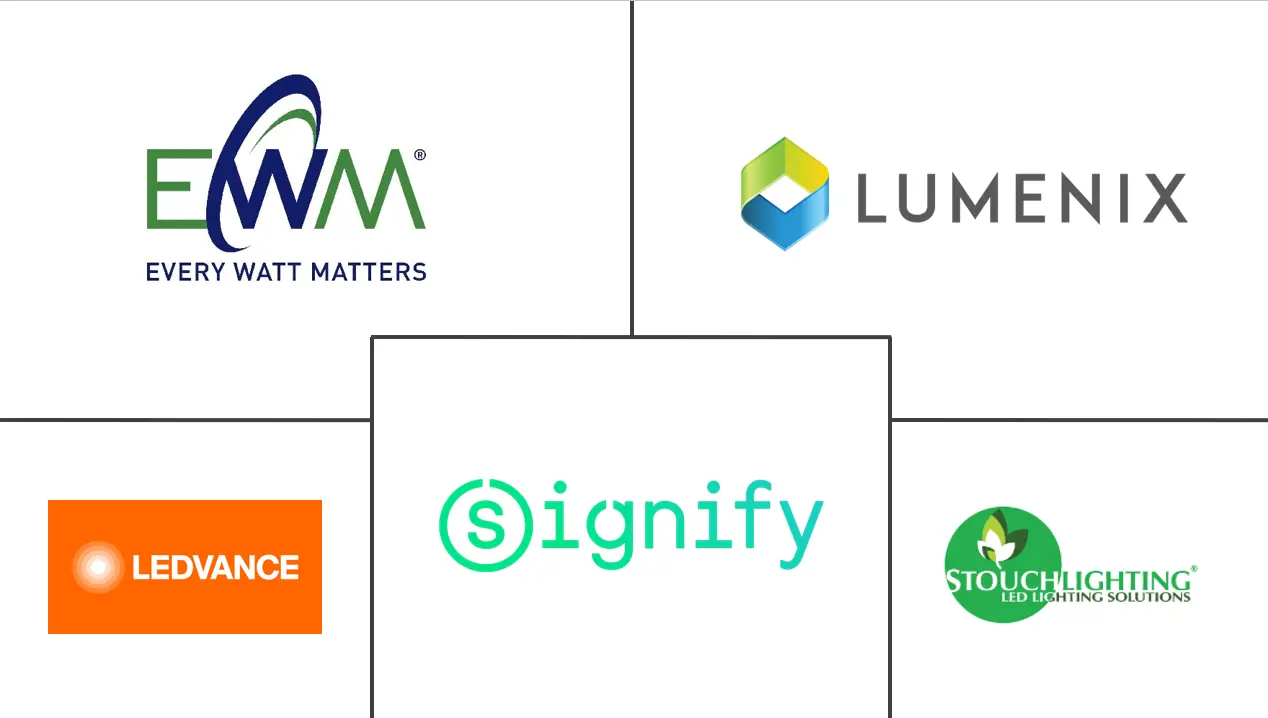Market Size of Lighting as a Service Industry

| Study Period | 2020 - 2029 |
| Base Year For Estimation | 2023 |
| CAGR | 50.04 % |
| Fastest Growing Market | North America |
| Largest Market | Europe |
| Market Concentration | Low |
Major Players
*Disclaimer: Major Players sorted in no particular order |
Lighting as a Service Market Analysis
The lighting as a service market is expected to grow at a CAGR of approximately 50.4% during the forecast period of 2020-2025. The primary driver for the market includes the increasing demand for efficient lighting systems. The growing convergence of the Internet of Things (IoT) in the lighting system has a lower consumption of energy across various parts of the world. However, the service's subscription program typically imposes a higher overall cost than the owner pays for the self-installation system, which can likely pose a challenge.
- Lighting-as-a-Service (LaaS), also known as Light-as-a-Service, is a service-based business model in which light service is charged on a subscription basis rather than via a one-time payment. It is managed by third parties more precisely by specialized service providers and may include light design, financing, installation, maintenance, and other services. The LaaS model has become more common in commercial and citywide installations of LED lights, specifically in retrofitting buildings and outdoor facilities, with the prior aim of reducing installation costs. Light vendors have used the LaaS strategy in selling value-added services, such as Internet-connected lighting and energy management.
- For instance, global LED use has increased substantially in recent years, rising from a market share of 5% in 2013 to nearly half of global lighting sales in 2019, with integrated LED luminaires making up an increasing share. Several developed markets, including the United States and Europe, are responsible for the rapid expansion of the luminaire market segment. At the same time, China has built a substantive domestic and global manufacturing base.
- Moreover, lighting accounts for nearly 10% of electricity usage in households and 18-40% of commercial premises. There is a growing need for energy saving across the globe, creating scope for the market. It is expected that the transition to energy-efficient lighting would reduce the global electricity demand for lighting by 30-40% in 2030. Using 50+% less energy consumption, LED lights to produce brighter, clearer light without the flicker that often irritates the optic nerve leading to employee complaints about headaches and fatigue. Additionally, LED lights contain NO hazardous materials, don't flicker or strobe, and are completely recyclable.
- Countries across the world are widely adopting LED lighting. For instance, New York planned to replace 250,000 streetlights with LEDs, which was to be followed by the replacement of decorative lights in the urban areas. Barcelona (Spain) deployed more than 3,000 smart streetlights based on LED technology, gathering information about pollution, humidity, noise, and the overall environment. Moreover, the US Department of Energy (DOE) anticipates that, by 2020, more than 75% of the outdoor luminaire shipments will be light-emitting diodes (LEDs).
- Additionally, with the continuing spread of COVID-19, technology vendors across the smart building sector are launching new propositions to help firms improve their buildings' infection control. In March 2020, lighting services firm Eco Energy Group (Eco E) launched a new suite of lighting products to help firms improve infection control in buildings. It launched the 'Smart UVC Solution' ultraviolet (UV) light, which can kill bacteria and viruses on surfaces. The 'Smart UVA Solution' can also disinfect surfaces through safe lighting rays. Eco E will deliver these solutions through a lighting-as-a-service business model that requires no capital expenditure.
Lighting as a Service Industry Segmentation
The lighting-as-a-service market studies the business model where the customer does not buy its lighting equipment. Rather it enters a multilayer contract that stipulates a flat fee for the lighting needs. The lighting player provides the lamps, luminaries, and controls and, in some cases, can also offer additional services, such as data analysis and financing arrangements. Separate installation companies install the lighting system and receive a fee from the lighting company for maintaining that equipment over the life of the contract. The study further covers the market growth by different end-users and their impact on the regions around the world.
| End User | |
| Commercial | |
| Outdoor | |
| Industrial |
| Geography | |
| North America | |
| Europe | |
| Asia-Pacific | |
| Latin America | |
| Middle East & Africa |
Lighting as a Service Market Size Summary
The Lighting as a Service (LaaS) market is experiencing significant growth, driven by the increasing demand for energy-efficient lighting systems and the integration of Internet of Things (IoT) technologies. This service-based model, which charges for lighting on a subscription basis rather than a one-time payment, is gaining traction in commercial and urban installations, particularly for retrofitting buildings and outdoor facilities. The LaaS model offers value-added services such as Internet-connected lighting and energy management, making it an attractive option for businesses looking to reduce installation costs and enhance energy efficiency. Despite the higher initial costs associated with subscription programs compared to self-installation systems, the potential for substantial energy savings and reduced electricity demand is a compelling factor for adoption.
The market is characterized by a fragmented landscape with key players like Every Watt Matters, Lumenix, Stouch Lighting, LEDVANCE GmbH, Signify Holdings, and ESB Light Manufacture of LED Luminaires. These companies are leveraging technological advancements and efficiency improvements to expand their product offerings. Government initiatives and standards promoting LED lighting are further fueling market growth. In North America, for instance, the United States and Canada are implementing various lighting standards and service projects to enhance energy conservation. The ongoing shift towards LED technology, coupled with the growing focus on sustainability and energy efficiency, is expected to drive the continued expansion of the LaaS market in the coming years.
Lighting as a Service Market Size - Table of Contents
-
1. MARKET DYNAMICS
-
1.1 Market Overview
-
1.2 Assessment of the COVID-19 Impact on the Industry
-
1.3 Recent Trends and Developments
-
1.4 Government Policies and Regulations
-
1.5 Industry Attractiveness - Porter's Five Forces Analysis
-
1.5.1 Bargaining Power of Suppliers
-
1.5.2 Bargaining Power of Consumers
-
1.5.3 Threat of New Entrants
-
1.5.4 Threat of Substitute Products and Services
-
1.5.5 Intensity of Competitive Rivalry
-
-
1.6 Value Chain / Supply Chain
-
1.7 Market Drivers
-
1.7.1 Government Policies for the Adoption of Energy-efficient Lighting Systems
-
1.7.2 Adoption of IoT with Lighting Systems
-
-
1.8 Market Challenges
-
1.8.1 Higher Overall Cost of the Subscription programs and Challenges for the Manufacturers Due to Price Fluctuation in the Near Future
-
-
-
2. MARKET SEGMENTATION
-
2.1 End User
-
2.1.1 Commercial
-
2.1.2 Outdoor
-
2.1.3 Industrial
-
-
2.2 Geography
-
2.2.1 North America
-
2.2.2 Europe
-
2.2.3 Asia-Pacific
-
2.2.4 Latin America
-
2.2.5 Middle East & Africa
-
-
Lighting as a Service Market Size FAQs
What is the current Lighting as a Service Market size?
The Lighting as a Service Market is projected to register a CAGR of 50.04% during the forecast period (2024-2029)
Who are the key players in Lighting as a Service Market?
Every Watt Matters, Lumenix, Stouch Lighting, LEDVANCE GmbH and Signify Holdings are the major companies operating in the Lighting as a Service Market.

